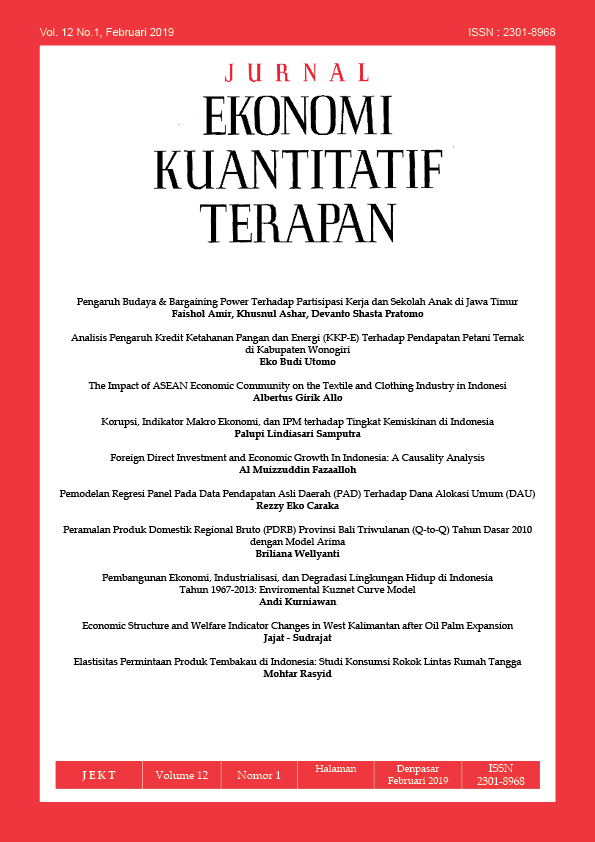Korupsi, Indikator Makro Ekonomi, dan IPM terhadap Tingkat Kemiskinan di Indonesia
Abstract
This study aims to identify the factors causing the poverty rate in Indonesia, both positive and negative impacts. There are three variables used in this study including HDI (Human Development Index), corruption (the amount of convicted corruption), and macro-economic indicators (inflation, GDP per capita, population).The variable of macro-economic indicators functioned as the control variable. To his study used panel data method consisting of the data from 2009 to 2013of 28 provinces in Indonesia. The model of poverty in Indonesia can be explained by Fixed Effect GLS model after passing the model selection and classic assumption collision testing. The results showed that among the three indicators, only the variable of GDP per capita having an insignificant effect on the poverty rate. Other factors have significant effects on thepoverty rate. There are two effects including positive and negative effects. The factors with the ability to reduce the poverty rate in Indonesia areHDI (greater effects in the provinces outside Sumatra and Java-Bali), inflation and population. Only the variable of corruption have a positive effect on the increasing poverty rate in Indonesia. The government needs to actively realize the alleviation of poverty program through human development in all provinces of Indonesia.
Downloads
References
Mempengaruhi Tingkat Kemiskinan
Di Kota Ambon (Studi Kasus di
Dusun Kranjang Desa Waiyame
Kec. Teluk Ambon dan Desa
Waiheru Kec. Teluk Ambon Baguala
Kota Ambon). Vol 1 No.1 Oktober
2012. Jurnal Agribisnis Kepulauan.
Harlik, Amir dan Hardiani (2013), Faktor-
faktor yang Mempengaruhi Kemiskinan dan engangguran di Kota Jambi. Jurnal Perspektif Pembiayaan dan Pembangunan Daerah Vol. 1, No.2. Oktober.
Khabibi, A (2013), Analisis Faktor-Faktor
yang Mempengaruhi Tingkat Kemiskinan (Studi Kasus 35 Kab/Kota di Provinsi Jawa Tengah Tahun 2011). Skripsi. Fakultas Ekonomi. Universitas Sebelas
Maret. Surakarta.
Rusdarti dan Sebayang, L.K (2013), Faktor-
faktor yang Mempengaruhi Tingkat
Kemiskinan di Provinsi Jawa
Tengah. Jurnal Economia. Vol 9. No.1 April
Al Jundi, M (2014), Analisis Faktor yang
Mempengaruhi Tingkat Kemiskinan
Provinsi-Provinsi di Indonesia.
Skripsi. Ilmu Ekonomi dan Studi Pembangunan. Fakultas Ekonomi dan Bisnis UNDIP.
Harahap, I (2002), Analisis Faktor-Faktor
Penyebab Kemiskinan Masyarakat
Desa (Studi Kasus Desa Bulucina
Tarutung Sihoda-hoda dan Desa
Gonting Jae. Kecamatan Barumun
Tengah Kabupaten Tapanuli
Selatan). Tesis. Program Pasca Sarjana. Universitas Sumatera Utara
Ajisafe, R.A (2016), Corruption and Poverty
in Nigeria : Evidence From Ardl Bound Test and Error Correction Model. Journal of Emerging Trends in Economics and Management Sciences (JETEMS)
Negin. V, Rasyid Z. A and Hesam N (2010),
The Causal Relationship Between Corruption and Poverty : A Panel Data Analysis. Munich Personal Repec Archive Paper No 24871. Posted 10 Sep 2010.
Aina dan Abuja (2014), How Corruption
Contributes to Poverty. Best Paper Award. International Conference 2014. 19-20 December, Chittagong, Bangladesh. Organized by : Center for Research and Publication International Islamic University Chittagong
Justesen and Christian. B (2012), Exploiting
The Poor : Bureaucratic Corruption
and Poverty In Africa. Afrobarometer
Working Papers, No. 139
Gonfa. A (2011), Corruption, Governance
and Poverty in Sub-Saharan Africa : Panel Evidence. Thesis. Master of Science in Economics. Addis ABABA University.
School of Graduate Studies
Gupta. S, Hamid, D dan Alonso (1998).
Does Corruption Affect Income Inequality and Poverty?. International Monetary Fund
Working Paper.
Pradiptyo R, Partohap dan PramaShavira
(2016). Korupsi Struktural : Analisis
Data Base Korupsi Versi 4 (2001-2015). Laboratorium Ilmu Ekonomi.
Departemen Ilmu Ekonomi. Fakultas
Ekonomi dan Bisnis. UGM.
CegahKrupsi.feb.ugm.ac.id
Bank of Indonesia, 2016. Laporan Inflasi (Indeks
Harga Konsumen)
http://www.bi.go.id/id/moneter/inflasi/data
Jumlah dan Persentase Penduduk Miskin,
Garis Kemiskinan, Indeks Keparahan Kemiskinan (P2) Menurut Provinsi www.bps.go.id
Rahayu, I.P (2012). Pengaruh Korupsi
Terhadap Kemiskinan di Indonesia. Program Studi S2 Ilmu Ekonomi dan Studi Pembangunan UGM.
http://etd.repository.ugm.ac.id
Negara, G.M dan Nasrudin, R (2013).
Analisis Hubungan Korupsi dan Kemiskinan Kabupaten/Kota di Indonesia. Program Studi Ilmu Ekonomi. Fakultas Ekonomi dan Bisnis UI. http://lontar.ui.ac.id/
Ainadan Abuja (2014), How Corruption
Contributes to Poverty.Best Paper Award.International Conference 2014.19-20 December, Chittagong, Bangladesh. Organized by : Center for Research and Publication International Islamic University Chittagong
Justesen and Christian. B (2012), Exploiting
The Poor : Bureaucratic Corruption
and Poverty In Africa. Afrobarometer
Working Papers, No. 139
Fraj,S.H and Amira L, 2015. Relationship between Corruption and Economic Growth : The Case of Developing Countries. International Journal of Economics, Commerce and Management. Vol III. Issue 9, September 2015. ISSN 2348 0386.
Brempong, K.G 2002. Corruption, Economic Growth and Income Inequality in Africa. Economics of Governance. Econ. Gov. (2002) 3 : 183-209.
Indonesian Central Bureau of Statistics.
Human Development Index According to Province 1996-2013. www.bps.go.id.
Indonesian Central Bureau of Statistics.
Amount of Poor Residents According to Provinces (2007-2017). www.bps.go.id.
Negin. V, Zakariah B.A Rashid and Hesam. N, 2011. The Causal Relationship Between Corruption and Poverty : A Panel Data Analysis. Journal of International Economics Review, 4 : 1(2011): 23-38.




















